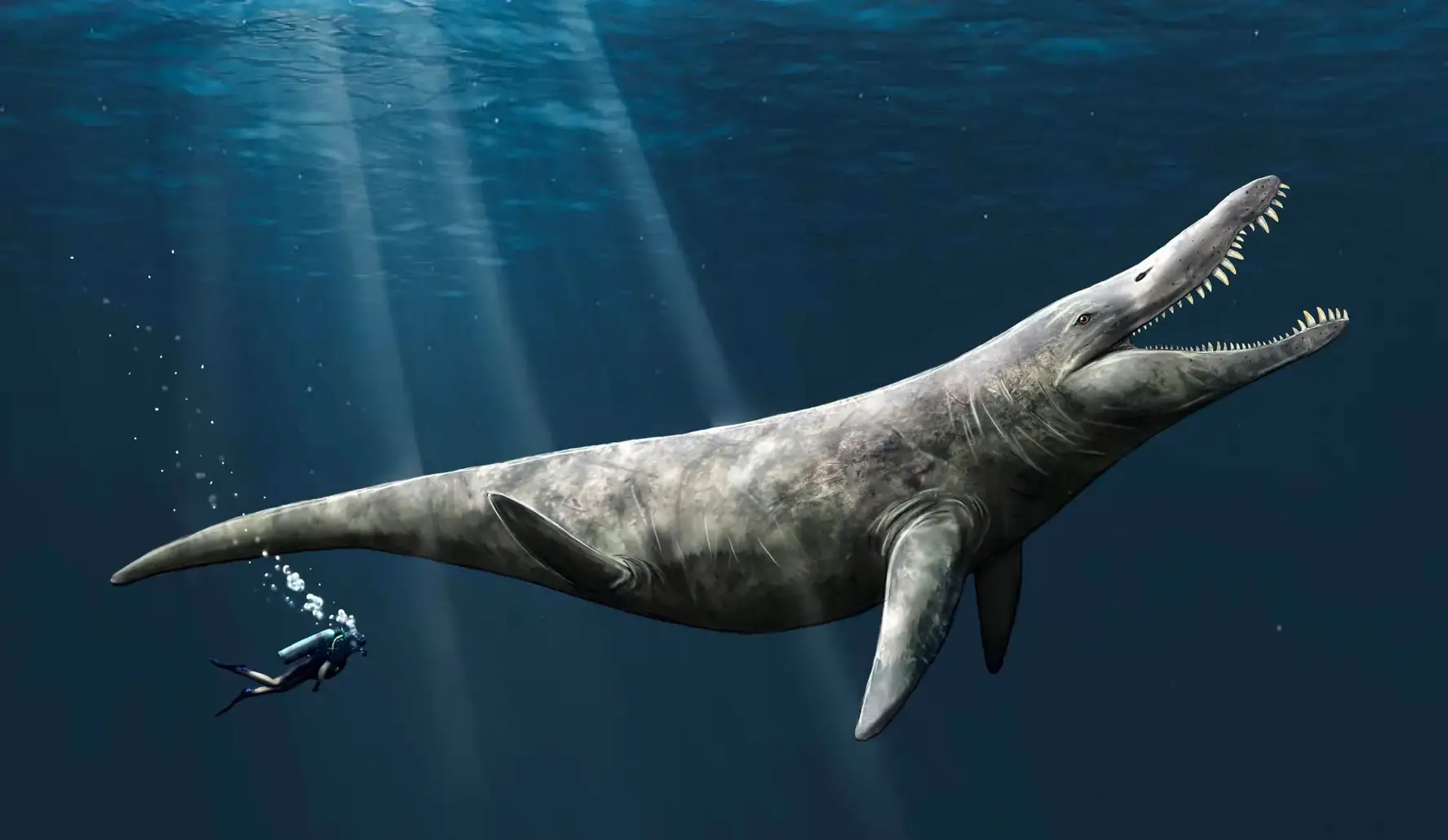
An artist’s impression of a pliosaur. Palaeontologists from the University of Portsmouth have found evidence suggesting that pliosaurs, closely related to Leopleurodon, could have reached 14.4 meters in length, twice the size of a killer whale. Credit: Megan Jacobs, University of Portsmouth
An Oxfordshire museum has discovered evidence that pliosaurs could have reached 14.4 meters in length, twice the size of a killer whale, following the discovery of four large vertebrae.
20 years ago, the BBC’s Walking With Dinosaurs TV documentary series showed a 25 meter long. Leopleurodon. This sparked heated debates about the size of this pliosaur, as it was overestimated and thought to have reached an adult size of just over six meters in length.
Speculation was destined to continue, but now a chance discovery in an Oxfordshire museum has led to the publication of a similar paper by a University of Portsmouth paleontologist.[{” attribute=””>species potentially reaching a whopping 14.4 meters — twice the size of a killer whale.
Professor David Martill from the University of Portsmouth’s School of the Environment, Geography and Geosciences, said: “I was a consultant for the BBC’s pilot program ‘Cruel Sea’ and I hold my hands up — I got the size of Liopleurodon horrendously wrong. I based my calculations on some fragmentary material that suggested a Liopleurodon could grow to a length of 25 meters, but the evidence was scant and it caused a lot of controversy at the time.

Digital three-dimensional scan images of pliosaur cervical vertebral centrum. Credit: University of Portsmouth
“The size estimate on the BBC back in 1999 was overdone, but now we have some evidence that is much more reliable after a serendipitous discovery of four enormous vertebrae.”
Professor Martill’s co-author, Megan Jacobs, was photographing an ichthyosaur skeleton at Abingdon County Hall Museum, while Dave looked through drawers of fossils. He found a large vertebra and was thrilled to discover the curator had three more of them in storage.
The vertebrae are clearly identifiable as being closely related to a Pliosaurus species or similar animal. Pliosaurs were like plesiosaurs, but with a bigger elongated head, similar to a crocodile, and a shorter neck. They had four flippers, which acted as powerful paddles to propel them through water, and a relatively short tail.

Diagram placing the Abingdon pliosaur in a ‘beauty contest’ with a range of recent aquatic and semi-aquatic vertebrates to show the overall body sizes. Credit: University of Portsmouth
After conducting topographic scans, Professor Martill and colleagues calculated this Late Jurassic marine reptile could have grown to between 9.8 and 14.4 meters long.
He said: “We know these pliosaurs were very fearsome animals swimming in the seas that covered Oxfordshire 145-152 million years ago. They had massive skulls with huge protruding teeth like daggers — as big, if not bigger than a T. rex, and certainly more powerful.
“They had a massive skull with huge protruding teeth like daggers — as big, if not bigger than a T. rex, and certainly more powerful.”
— Professor David Martill, Professor of Palaeobiology
“They were at the top of the marine food chain and probably preyed on ichthyosaurs, long-necked plesiosaurs and maybe even smaller marine crocodiles, simply by biting them in half and taking chunks off them. We know they were massacring smaller marine reptiles because you can see bite marks in ichthyosaur bones in examples on display in The Etches Collection in Dorset.”
The vertebrae were originally discovered during temporary excavations at Warren Farm in the River Thames Valley in Oxfordshire and come from the Kimmeridge Clay Formation. This deposit is Late Jurassic in age, around 152 million years old.

Map of the region around Abingdon showing the location (starred) of the discovery site of the four pliosaur cervical vertebrae. Credit: University of Portsmouth
Professor Martill added: “It’s wonderful to prove there was indeed a truly gigantic pliosaur species in the Late Jurassic seas. Although not yet on a par with the claims made for Liopleurodon in the iconic BBC TV series Walking With Dinosaurs, it wouldn’t surprise me if one day we find some clear evidence that this monstrous species was even bigger.”
The paper is published in The Proceedings of the Geologists’ Association.
Reference: “A truly gigantic pliosaur (Reptilia, Sauropterygia) from the Kimmeridge Clay Formation (Upper Jurassic, Kimmeridgian) of England” by David M. Martill and Megan L. Jacobs, Roy E. Smith, 10 May 2023, Proceedings of the Geologists’ Association.
DOI: 10.1016/j.pgeola.2023.04.005
#sea #monsters #Jurassic #seas #size #killer #whales
